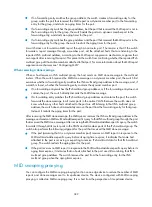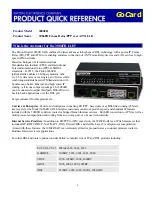
374
Configuring IPv6 multicast routing and
forwarding
Overview
In IPv6 multicast implementations, the following types of tables implement multicast routing and
forwarding:
•
Multicast routing table of an IPv6 multicast routing protocol
—Each IPv6 multicast routing protocol
has its own multicast routing table, such as the IPv6 PIM routing table.
•
General IPv6 multicast routing table
—The multicast routing information of different IPv6 multicast
routing protocols forms a general IPv6 multicast routing table.
•
IPv6 multicast forwarding table
—The IPv6 multicast forwarding table guides the forwarding of IPv6
multicast packets.
An IPv6 multicast forwarding table consists of a set of (S, G) entries. Each entry contains the routing
information for forwarding multicast data from a multicast source to a multicast group. If a router supports
multiple IPv6 multicast protocols, its IPv6 multicast routing table contains all routes that these protocols
have generated. The router chooses the optimal route from the IPv6 multicast routing table based on the
configured multicast routing and forwarding policy and adds the route entry into its IPv6 multicast
forwarding table.
RPF check mechanism
An IPv6 multicast routing protocol relies on the existing IPv6 unicast routing information or IPv6 MBGP
routes in creating IPv6 multicast routing entries. When creating IPv6 multicast routing table entries, an
IPv6 multicast routing protocol uses the RPF check mechanism to ensure IPv6 multicast data delivery
along the correct path. The RPF check mechanism also helps avoid data loops caused by various
reasons.
A multicast routing protocol uses the following tables to perform the RPF check:
•
IPv6 unicast routing table
—Contains unicast routing information.
•
IPv6 MBGP routing table
—Contains IPv6 MBGP multicast routing information.
When performing an RPF check, a router searches its IPv6 unicast routing table and IPv6 MBGP routing
table at the same time. The specific process is as follows:
1.
The router chooses an optimal route from the IPv6 unicast routing table and the IPv6 MBGP routing
table, respectively.
{
The router searches its IPv6 unicast routing table by using the IPv6 address of the packet source
as the destination address and automatically selects an optimal route. The outgoing interface of
the route is the RPF interface and the next hop is the RPF neighbor. The router considers the path
of the IPv6 multicast packet that the RPF interface receives from the RPF neighbor as the shortest
path that leads back to the source.
{
The router searches its IPv6 MBGP routing table by using the IPv6 address of the packet source
as the destination address and automatically selects an optimal MBGP route. The outgoing
interface of the route is the RPF interface and the next hop is the RPF neighbor.
















































